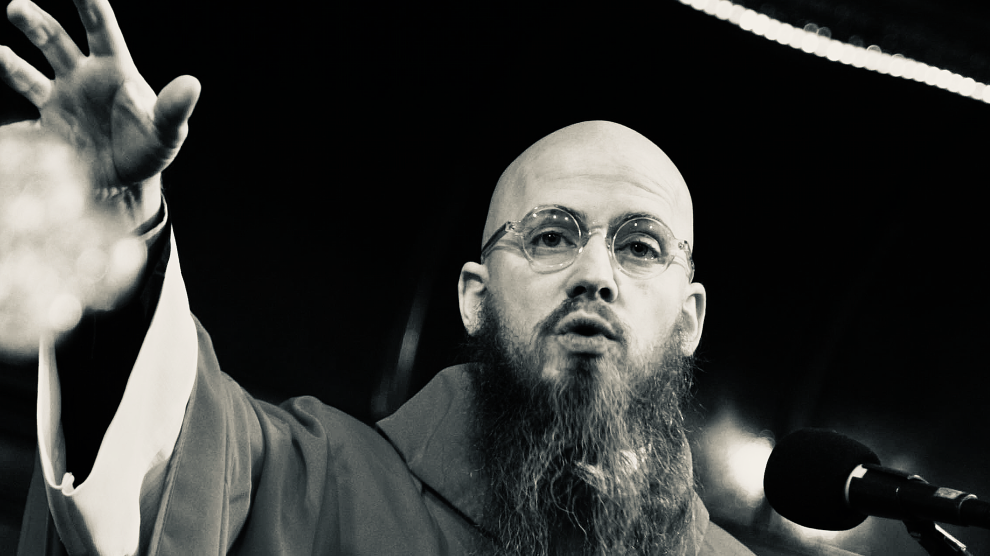On a sunny March afternoon, with temperatures in Yellowstone National Park soaring into the 30s, a lanky young man in black-and-purple wraparound shades lounges on a snowbank next to the waters of Duck Creek. He is watching a small herd of bison poke around in the shallows, looking for something to graze. He holds a camcorder in his hand, ready to record any action. Geoff Farinholt is not some college kid on spring break; he is an activist for the Buffalo Field Campaign. His job is to watch these hungry buffalo and keep them from crossing the unfenced park border into Montana. There, just 100 yards to the west, stacked with fragrant hay, stands a bison capture corral operated by the state Department of Livestock (DOL).
Once buffalo leave the confines of the park, the state of Montana has the legal right to kill them. That’s because some of them carry brucellosis, a bacterial disease that can induce cows to abort their first calves and can cause debilitating fever in humans. If these bison head for the hay, they will be captured and tested for exposure to the disease, and most likely sent to slaughter.
The Yellowstone bison are casualties of one of the most anguished, politicized wildlife disputes in U.S. history. In 1985, Montana’s cattle were declared brucellosis-free, and the state is determined to keep it that way. Once rampant throughout the United States, brucellosis is now rarely found outside the greater Yellowstone area. Cattle can theoretically catch it from contact with bison that carry the disease — although this has never been demonstrated outside a laboratory. Still, over the past decade, some 3,000 bison have been killed in the name of Montana’s cattle industry, often on national forest lands.
Mainstream conservation groups have been fighting in the courts and on op-ed pages to stop the slaughter. But only the ragtag volunteers from the Buffalo Field Campaign (BFC) have been out on the front lines every day. More than 400 volunteers have cycled through the two-year-old campaign: students, Earth First! veterans, hippies, New Age dropouts, radical vegans, and curious wanderers who are willing to live in a cramped log cabin in West Yellowstone — one of the coldest places in the contiguous 48 states — and risk getting trampled, frostbitten, arrested, and thrown in jail to help save the last wild herd of American bison.
“It’s much more important to save these last few thousand wild buffalo than it is to preserve the overabundant cattle,” says Mike Mease, 38, co-founder of the BFC. “We need to let the American people know that this is their last wild herd of buffalo and it’s in their best interest to preserve them for their children’s future.”
Every day during the killing season, BFC patrols set out on skis, on snowshoes, and in vehicles to defend the Yellowstone bison. This can involve videotaping Department of Livestock operations, stopping traffic on U.S. 191 when livestock agents on snowmobiles chase bison across the road, or committing acts of civil disobedience. In some cases, campaigners have locked themselves to stock trailers to slow down DOL operations, or have engaged in other nonviolent acts for which they are arrested by local sheriffs or deputized livestock agents. This past winter, BFC protesters set up 30-foot-tall log tripods in the middle of roads to obstruct DOL vehicles, and then camped out atop the tripods. One blockade lasted more than a month before deputies used a cherry picker to take it down. But most BFC activists simply follow the bison around to make sure they stay out of trouble.
Think of them as buffalo bodyguards.
“This is about as close as we like to let ’em get,” Geoff tells a visitor as he scans the herd in Duck Creek. If the buffalo try to leave the park, the volunteers are trained to “haze,” or shepherd, them back to safety. “Basically, you just throw your hands up and make a little noise and detour them back the way they came,” he explains. And then, as if to test him, two young bull bison suddenly bolt out of the creek bed and make for Montana.
“Shit!” screams Geoff, leaping to his feet. He and his patrol partner, whooping and flapping their arms, struggle through the deep snow to get ahead of the bulls.
“Hee-yahhh! Tshhhhh! Hee-yaahh!”
The bison, which can weigh up to a ton and can toss a grown man like a beanbag, try to outflank their pursuers by running toward some pine trees. The volunteers follow, shouting, “Hee-yahh!” Finally, the bison give up and stomp back to the creek.
“Those two are grounded!” Geoff yells after them, sucking gulps of thin mountain air. “Bad buffalo!”
But the victory was temporary. Before the winter’s end, more than 90 buffalo had slipped past the activists to be captured and killed in Montana. It could have been worse. Two consecutive mild winters have meant fewer bison leaving Yellowstone’s high country in search of food. But even with the help of the weather, the death count might have been higher had it not been for the BFC volunteers keeping watch on the animals — and on the livestock agents.
“I think more bison would have been killed without the Buffalo Field Campaign,” says Jeanne-Marie Souvigney of the Greater Yellowstone Coalition, a conservation group based in Bozeman, Montana. “They had a tremendous role in not only keeping this issue in front of the public, but in moving animals away from the people with the guns.”
The state of Montana maintains that it has no choice in the matter — animal health officers from other states have threatened to bar imports of Montana cattle if officials don’t control the brucellosis threat. The state’s bison policy is part of an agreement with the federal government that has been upheld in court. According to Julie Lapeyre, a spokeswoman for Republican Gov. Marc Racicot, Montana has nothing against bison: It’s brucellosis the state can’t tolerate.
“We’re no different than most Americans — we like wildlife,” says Lapeyre. “We don’t like to shoot bison; we don’t like to remove bison. However, there are statutes and rules that have to be abided by, and we have an obligation to protect our livestock industry and human health.”
But even officials of the federal Animal and Plant Health Inspection Service (APHIS), which in the past has threatened to reevaluate the brucellosis-free status of Montana cattle, now say the state is overreacting to the danger of brucellosis. “The risk (of transmission) is very, very small, but it is very, very real,” says APHIS spokesman Patrick Collins. “We have to be very prudent and careful to ensure that it doesn’t happen. [But] we think there are other much more acceptable ways to achieve the policy goal, which is maintaining a healthy cattle population, without killing scores of bison.”
Conservationists say the problem is cattle; ranchers say the problem is bison. There is a vaccine for cattle, and when it is used with other management techniques — such as making sure that bison and cattle remain apart on the range — it satisfies federal regulations. That’s how Wyoming deals with brucellosis. But that practice is apparently not good enough for Montana.
While most citizens view the Yellowstone bison as majestic American icons, nurtured and protected in the park, Montana’s cattlemen and the politicians they support see them as reservoirs of contagion and symbols of a much-resented federal authority. Clearly this fight isn’t just about disease eradication; it’s about power and the control of public lands — an old and bitter issue in the American West.
“This whole thing has nothing to do with brucellosis,” says Steve Torbit, senior scientist for the National Wildlife Federation. “It has everything to do with who manages wildlife.”
Next: The volunteers have come from around the world and are poised to endure the grueling Yellowstone winter, with help from local supporters. But will the U.S. Animal Health Association’s stringent “final solution” to the supposed brucellosis problem destroy America’s most cherished bison herd nonetheless?
For the rest of this article, pick up the Nov./Dec. 1999 issue of Mother Jones at your local independent bookstore or any national chain bookstore.
Additional MoJo Coverage
Buffalo Soldiers Take Position
Update: The bison in Yellowstone are on the move, and their self-appointed bodyguards from the Buffalo Field Campaign are once again in the line of fire. (The MoJo Wire, 12/99)
Buffaloed
How Montana hoodwinked two federal agencies and asserted deadly control over the Yellowstone bison (The MoJo Wire, 6/98)
- Brucellosis Fever
Ranchers fear it–but do wild bison really give cattle the dread disease? - Cattlemen’s Club
Critics say APHIS is too cozy with livestock producers
Other Bison Resources
- Buffalo Field Campaign
- Montana Department of Livestock
- Inter-Tribal Bison Cooperative
Group dedicated to restoring bison to tribal lands - Buffalo Commons
A strategic initiative of Honor the Earth, an inter-tribal environmental action group. Includes periodic news updates and audio reports - American Buffalo: Spirit of a Nation
PBS special on the history of the bison in America - Center for Bison Studies, Montana State University
- Bringing Buffalo Back
Facts from the National Wildlife Federation - USDA Cattle and Bison Page
An overview from the Department of Agriculture’s Animal and Plant Health and Inspection Service, focussing on the Yellowstone herd and surrounding ranches - National Park Service: Yellowstone Bison
The government’s overview of the bison vs. ranchers fight. - Brucellosis in Yellowstone
The National Academy of Science’s research project on brucellosis - Bison Activist Guide
A proposal to save Yellowstone bison, courtesy of Defenders of Wildlife in Washington, DC.

















